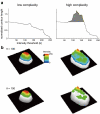Changes in chromatin structure during processing of wax-embedded tissue sections
- PMID: 20661639
- PMCID: PMC2941078
- DOI: 10.1007/s10577-010-9147-6
Changes in chromatin structure during processing of wax-embedded tissue sections
Abstract
The use of immunofluorescence (IF) and fluorescence in situ hybridisation (FISH) underpins much of our understanding of how chromatin is organised in the nucleus. However, there has only recently been an appreciation that these types of study need to move away from cells grown in culture and towards an investigation of nuclear organisation in cells in situ in their normal tissue architecture. Such analyses, however, especially of archival clinical samples, often requires use of formalin-fixed paraffin wax-embedded tissue sections which need addition steps of processing prior to IF or FISH. Here we quantify the changes in nuclear and chromatin structure that may be caused by these additional processing steps. Treatments, especially the microwaving to reverse fixation, do significantly alter nuclear architecture and chromatin texture, and these must be considered when inferring the original organisation of the nucleus from data collected from wax-embedded tissue sections.
Figures






Similar articles
-
Improved technique for fluorescence in situ hybridisation analysis of isolated nuclei from archival, B5 or formalin fixed, paraffin wax embedded tissue.Mol Pathol. 2002 Apr;55(2):121-4. doi: 10.1136/mp.55.2.121. Mol Pathol. 2002. PMID: 11950961 Free PMC article.
-
A rapid and simplified technique for analysis of archival formalin-fixed, paraffin-embedded tissue by fluorescence in situ hybridization (FISH).Anticancer Res. 1996 Sep-Oct;16(5A):2533-6. Anticancer Res. 1996. PMID: 8917347
-
Preparation of cells from formalin-fixed, paraffin-embedded tissue for use in fluorescence in situ hybridization (FISH) experiments.Curr Protoc Hum Genet. 2007 Jan;Chapter 8:Unit 8.8. doi: 10.1002/0471142905.hg0808s52. Curr Protoc Hum Genet. 2007. PMID: 18428417
-
Making Formalin-Fixed, Paraffin Embedded Blocks.Methods Mol Biol. 2019;1897:253-268. doi: 10.1007/978-1-4939-8935-5_22. Methods Mol Biol. 2019. PMID: 30539450 Review.
-
Microtomy: Cutting Formalin-Fixed, Paraffin-Embedded Sections.Methods Mol Biol. 2019;1897:269-278. doi: 10.1007/978-1-4939-8935-5_23. Methods Mol Biol. 2019. PMID: 30539451 Review.
Cited by
-
Fluorescence in situ hybridization with high-complexity repeat-free oligonucleotide probes generated by massively parallel synthesis.Chromosome Res. 2011 Oct;19(7):901-9. doi: 10.1007/s10577-011-9245-0. Epub 2011 Oct 18. Chromosome Res. 2011. PMID: 22006037 Free PMC article.
-
Epigenetically induced changes in nuclear textural patterns and gelatinase expression in human fibrosarcoma cells.Cell Prolif. 2013 Apr;46(2):127-36. doi: 10.1111/cpr.12021. Cell Prolif. 2013. PMID: 23510467 Free PMC article.
-
Proposal of criteria for dyserythropoiesis in the diagnosis of myelodysplastic syndromes.Int J Hematol. 2016 Feb;103(2):227-33. doi: 10.1007/s12185-015-1916-8. Epub 2015 Nov 25. Int J Hematol. 2016. PMID: 26608365
-
Multiscale chromatin dynamics and high entropy in plant iPSC ancestors.J Cell Sci. 2024 Oct 15;137(20):jcs261703. doi: 10.1242/jcs.261703. Epub 2024 Jun 24. J Cell Sci. 2024. PMID: 38738286 Free PMC article.
-
High-resolution microscopy for imaging cancer pathobiology.Curr Pathobiol Rep. 2019;7(3):85-96. doi: 10.1007/s40139-019-00201-w. Epub 2019 Jul 11. Curr Pathobiol Rep. 2019. PMID: 32953251 Free PMC article.
References
Publication types
MeSH terms
Substances
Grants and funding
LinkOut - more resources
Full Text Sources
Other Literature Sources
Miscellaneous

